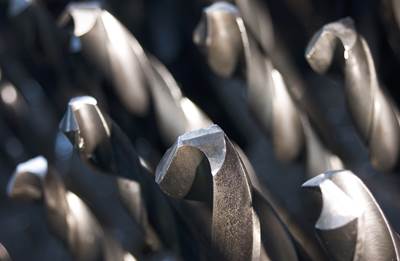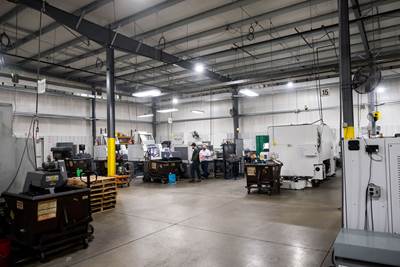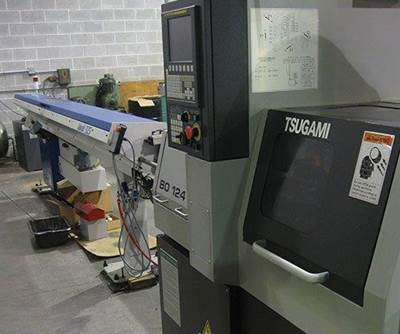Share






Nomura DS’s 20J3XBTC is a Swiss-type machine with a fully programmable second B-axis on the subspindle that can operate concurrently with the B-axis on the main spindle. Manufacturers can use this added machining capacity to machine parts faster and more efficiently, often producing complex parts complete. Photos by Julia Hider, MMS.
For shops looking to increase unattended machining, Swiss-type lathes are among the best options. With the help of a bar feeder and parts catcher, these machines can run unattended for hours, often producing complete parts. The addition of a B-axis with live tooling enables the machine to handle more intricate parts. However, this doesn’t always equate to machining efficiency, particularly when parts require complex machining on both sides, such as those frequently seen in the medical and aerospace industries.
Nomura DS’s 20J3XBTC Swiss-type machine has B-axes on both the main spindle and subspindle, enabling the machine to perform more complex work on the subspindle than a traditional Swiss-type machine. “When the subspindle comes in and grabs the part, you’ve got another machine behind it doing work on the other end of the part,” explains Chris Moore, an applications engineer for Nomura DS machines at Gosiger, one of the largest distributors for Nomura DS.

The 20JTXBTC’s B-axes are supported from both the top and the bottom, enabling them to take on heavier cuts than traditional B-axes, which are only supported from the top and best suited to finishing operations.
B-Side Machining
The 20J3XBTC isn’t the only Swiss-type with a second B-axis, but Ryan Mitchell, Nomura DS’s product manager at Gosiger, says he believes this is the only one where the second B-axis is fully programmable and can perform machining operations at the same time as the B-axis on the main spindle. “Everything else I have seen has one programmable B-axis on the main that covers the main and subspindles, so one side is idle, or they have a manually adjustable B-axis for the subspindle.” According to him, this second B-axis isn’t difficult to program once users understand the capabilities of the machine. “The Mitsubishi control is very powerful and can work out the movements without making the program overly complicated,” he adds.
According to Moore, another feature that sets Nomura DS’ machine apart from others on the market is that it is supported from both the top and the bottom. Typically, B-axes are supported only from the top, which means they have less stability and are generally limited to performing finishing operations. “We’re able to do a lot heavier milling, a lot heavier profiling on the backworking spindle because the B-axis is better supported,” he notes.
The machine’s stability extends beyond the B-axes. Moore notes that 20J3XBTC features a solid machine base, dovetail slides and a cooling system that all boost the machine’s rigidity, making it well suited to precise applications and harder materials.

The added machining capabilities of the second 20J3XBTC’s B-axis can increase throughput by eliminating secondary operations, balancing cycle times and improving cutting tool performance.
A Balancing Act
One of the primary benefits of the 20J3XBTC’s second B-axis is the possibility of drastic reductions in cycle time, particularly when compared to traditional lathes. “We were able to bring jobs off of a regular lathe because they were making the parts out of barstock and they would run a six-minute cycle time. We can put the part on this machine and drop it complete in under a minute,” Moore says.
The second B-axis can also enable manufacturers to produce complex parts that previously required multiple secondary operations complete. Mitchell says that for one user, the 20J3XBTC was able to machine a part in one operation, replacing multiple custom-built machines that were previously necessary for secondary operations.
The second B-axis could have a number of benefits beyond cycle time reduction and machining complex parts complete. For example, the additional machining capabilities of the subspindle also enable users to equalize the cycle times between the two spindles, reducing overall cycle times and maximizing machining efficiency. “Having the ability to do the same thing on the subspindle as you’re doing on the main spindle means you’re going to have a better cycle time because you can balance the cycle,” Moore points out.
The machine’s stability could also contribute to improved tool life. Users can perform separate roughing and finishing operations on the second B-axis using cutting tools designed for each operation. A second B-axis means more tooling capacity — the B-axis on the main spindle holds five live tools, while the one on the subspindle holds four. And both have the power to properly handle both roughing and finishing tools. “We can go up to 6,000 rpm on our live tools,” Moore adds, which, along with high-pressure coolant, can help improve tool life. Tool life and performance is also increased by Nomura’s Micro Vibration Turning technology, which creates vibrations in the feed axis. These vibrations produce air cutting zones that break up chips and reduce heat during cutting.
Related Content
Quick-Change Tool Heads Reduce Setup on Swiss-Type Turning Centers
This new quick-change tooling system enables shops to get more production from their Swiss turning centers through reduced tool setup time and matches the performance of a solid tool.
Read MoreIndustry Analysis: Machining Semiconductor Components
With many machine shops anticipating long-term growth in demand from the semiconductor industry, it is worth the time to heed the advice of manufacturers who have already been servicing this end-market for years.
Read MoreInside the Premium Machine Shop Making Fasteners
AMPG can’t help but take risks — its management doesn’t know how to run machines. But these risks have enabled it to become a runaway success in its market.
Read MoreA History of Precision: The Invention and Evolution of Swiss-Style Machining
In the late 1800s, a new technology — Swiss-type machines — emerged to serve Switzerland’s growing watchmaking industry. Today, Swiss-machined parts are ubiquitous, and there’s a good reason for that: No other machining technology can produce tiny, complex components more efficiently or at higher quality.
Read MoreRead Next
Eight Articles to Understand Live Tooling
A roundup of the most read articles about live tooling on Modern Machine Shop.
Read MoreSwiss-Type, Live Tooling Lathes Help Turn Company Around
New leadership’s investment in Swiss-type and live tooling lathes has enabled Rathburn Tool & Manufacturing to expand into new markets, reversing the company’s sluggish growth.
Read MoreUnderstanding Swiss-Type Machining
Once seen as a specialty machine tool, the CNC Swiss-type is increasingly being used in shops that are full of more conventional CNC machines. For the newcomer to Swiss-type machining, here is what the learning curve is like.
Read More






















.jpg;maxWidth=300;quality=90)








